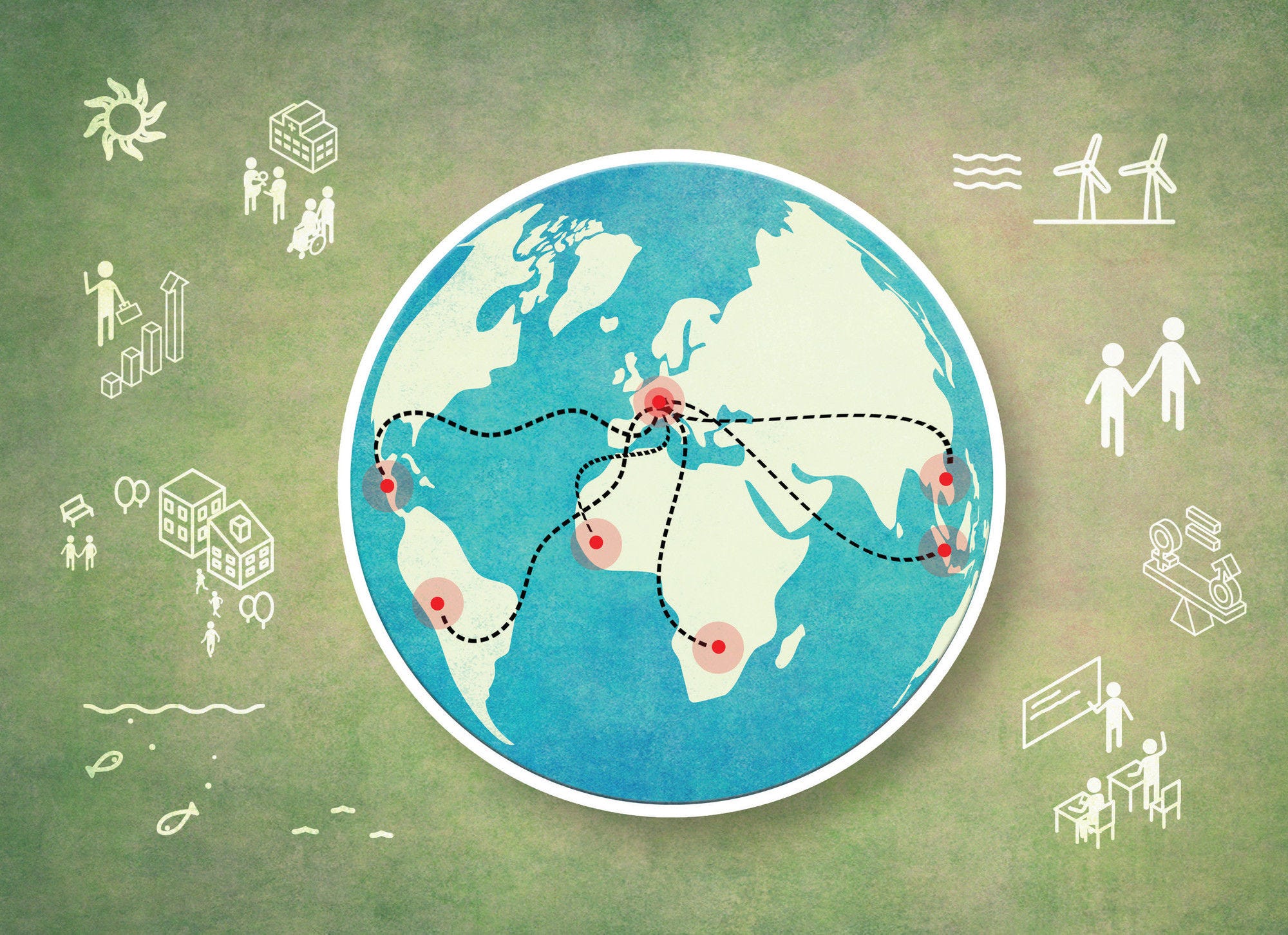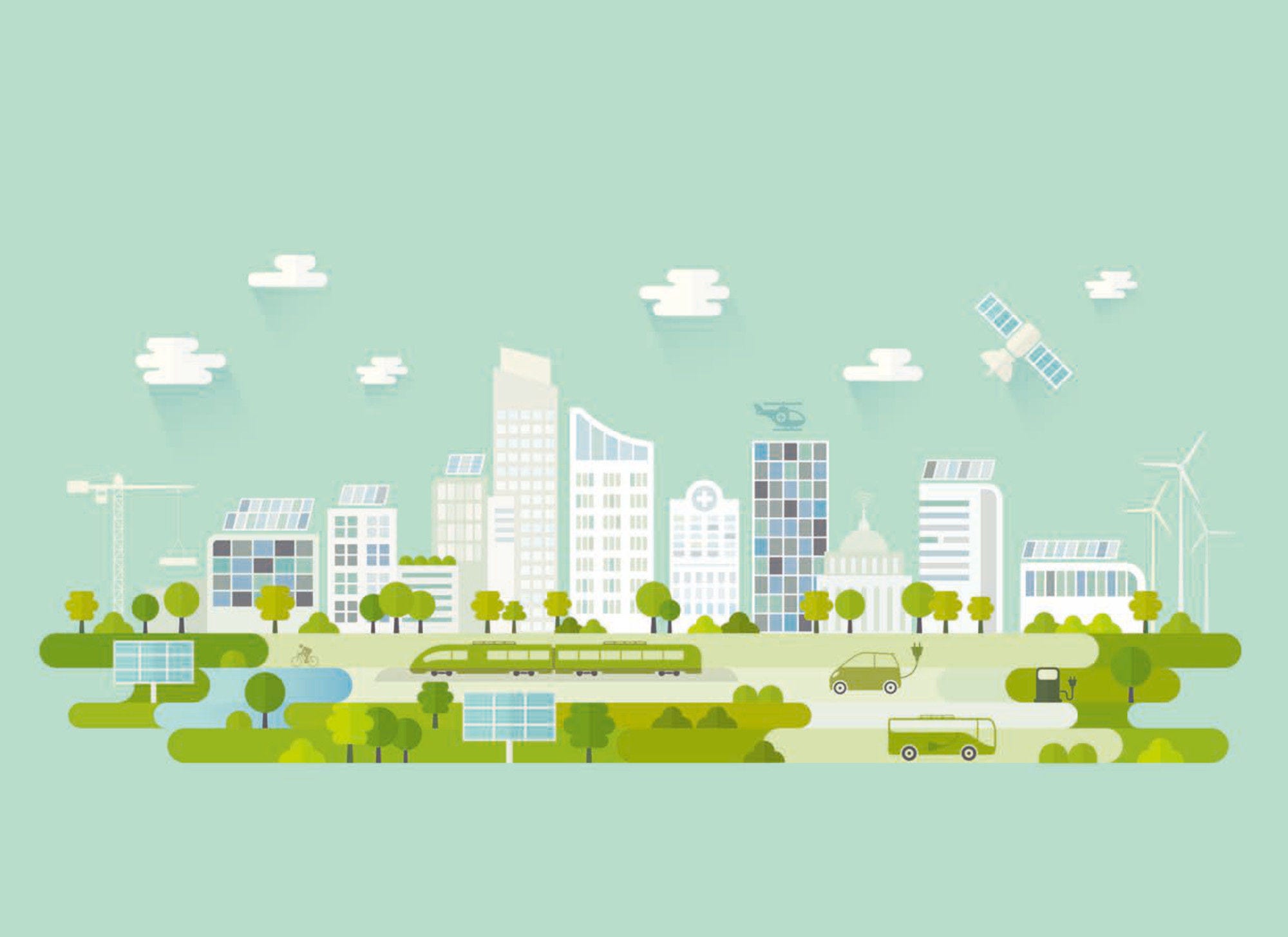Ireland is at a turning point for the transition to a circular economy. The 2022 Whole of Government Circular Economy Strategy provides the policy framework for the circular economy in the country, and the forthcoming Circular Economy Bill is expected to strengthen waste and circular economy legislation. Nevertheless, with a circularity material use rate of 2% in 2020, Ireland shows significant scope for progress. The report analyses the state of play and challenges of the circular transition in Ireland and provides policy recommendations for circular economy policy across levels of government. It is the result of a two-year policy dialogue between the OECD, the Department of the Environment, Climate and Communications, as well as a broad range of public, private and civil society stakeholders.
The Circular Economy in Ireland

Abstract
Executive Summary
Drivers for the circular economy in Ireland
Ireland is at a turning point in its transition towards the circular economy, which aims to prevent waste and pollution, keep resources in use for as long as possible and transform waste into resources. Driven by international and European Union (EU) agendas on climate and waste, particularly the Paris Agreement, the EU Green Deal and the EU Circular Economy Package, Ireland recently developed a Waste Action Plan for a Circular Economy (2020-2025) and a Whole of Government Circular Economy Strategy (2022). It is also preparing the ground for a Circular Economy Bill.
With a circular material use rate of just 2% in 2020 (relative to an EU average of 12.8%), Ireland has significant scope for progress. Recycling rates for municipal solid waste for the past 5 years have stagnated at around 40% (compared to EU recycling targets of 55% by 2025) and waste generation has been increasing since the recovery from the 2008 economic crisis. Preventing waste, repairing, reusing and recycling holds great promise for the Irish economy in terms of job creation, greenhouse gas (GHG) emissions reduction and environmental sustainability. Already in 2014, the Clean Technology Centre estimated that a 5% increase in resource efficiency would result in annual savings of EUR 2.3 billion for the Irish economy.
Recent events affecting the Irish economy have driven further reflections on resource efficiency and supply chains. Brexit heightened awareness of the limitations of global supply chains, particularly in the agri-food sector, which exported up to 40% of its output to the United Kingdom pre-Brexit. Across sectors, rising energy prices are also driving momentum for greater energy efficiency. Public spending in response to the COVID-19 pandemic has strengthened the government’s ambition for the green transition. In 2021, around one-third of the EUR 10 billion investment envelope in Ireland’s State Budget was allocated to sustainable transport and water infrastructure, energy efficiency and renewables, landfill remediation and peatland rehabilitation.
Demographic changes, urbanisation patterns and climate change will also play a role in the future of resources management in Ireland. Ireland’s population of 4.9 million is growing almost twice as fast as the OECD average (1% per year, compared to 0.6%, between 2013 and 2018), calling for an estimated 300 000 new homes by 2030. Between 2013 and 2019, construction grew 8 times faster in Ireland than in the EU27, generating environmental consequences as residential and commercial buildings account for 15% of GHG emissions, and construction waste accounted for 15% of total waste generation. Applying circular economy principles to the built environment, including using the existing building stock more efficiently, designing modular buildings and reusing construction materials, can contribute to achieving carbon neutrality by 2050, as set out in the Climate Action Plan.
Unlocking the potential of the circular economy in Ireland
The circular economy is not entirely new in Ireland, as the past two decades have seen a growing number of government-led waste prevention and circular economy initiatives. Levies on plastic bags and waste were successful in preventing plastic bag use (-97.5% between 2001 and 2018) and drastically reducing landfilling (from 80% of municipal waste in 2002 to just over 10% in 2018). Since 2004, the Environmental Protection Agency (EPA) National Waste Prevention Programme has been instrumental in raising awareness, improving know-how and through engagement with a wide range of stakeholders on waste prevention. The EPA’s new Circular Economy Programme will co-ordinate circular economy initiatives across levels of government and stakeholders. A set of government-supported funding schemes, such as the EPA’s Green Enterprise Fund (EUR 625 000 in 2021), the Department of the Environment, Climate and Communications (DECC) Circular Economy Innovation Grant Scheme (EUR 490 000 in 2021) and CIRCULÉIRE’s innovation fund (EUR 1.5 million between 2020 and 2022) supports circular economy solutions across businesses, social enterprises and community-based organisations. Recognising the role of public procurement (which accounts for around 10-12% of Irish gross domestic product annually) in the circular and green transition, the national government has supported capacity building on green public procurement (GPP) across levels of government.
Cities in Ireland are home to several circular initiatives and local authorities are well placed to lead the transition from the bottom up. The 2014 Local Government Reform Act granted new responsibilities to local authorities that include planning, economic and community development. As such, local authorities can identify, map and provide support for circular initiatives among local businesses and civil society, bridging gaps between sectors and key players. For instance, Dublin City Council’s Corporate Plan 2020-2024 identified the circular economy as one of the sectors to support, along with green business, tourism and food. With support from the EPA, Monaghan County Council developed the RepairMyStuff website, an online platform that connects people with local repair businesses.
Ireland has three Regional Waste Management Planning Offices (Southern, Eastern-Midlands and Connacht-Ulster) responsible for co-ordinating the implementation of statutory regional Waste Management Plans with local authorities. However, by the end of 2022, Ireland will move from regional Waste Management Plans for each of the three regional offices to a National Waste Management Plan for a Circular Economy 2022-2028 setting the same targets for all three regions. The regional offices will continue co-ordinating the implementation of the Plan at the local authority level, as well as supporting circular economy businesses (e.g. Bounce Back Recycling), providing upcycling schemes (e.g. for bicycles, toys and clothes), raising awareness on waste (e.g. MyWaste.ie information platform), and educating a range of stakeholders on circular economy (e.g. Schools Composting Project), among others.
The shift to a circular economy can also help strengthen urban-rural linkages in Ireland, where 75% of the territory is farmland and 40% of the population live in the capital city, Dublin. Farmers’ markets, co-operative stores in cities and towns, food distribution networks in neighborhoods and community-supported agriculture are well-established in Ireland and contribute to narrowing food loops. More broadly, non-governmental stakeholders play a key role in Ireland’s circular transition. Businesses, including small- and medium-sized enterprises (SMEs) and social enterprises, drive reuse, repair, remanufacturing and recycling practices, while knowledge institutions and universities carry out research and provide education and training on the circular economy.
Main governance challenges for Ireland’s transition towards the circular economy
Ireland’s circular economy policy needs to overcome three main obstacles. First, Ireland has a sectoral view of the circular economy, mainly based on waste, rather than a broader view of resource management and a holistic approach to leverage the circular economy as a cross-sectoral driver of economic growth, job creation, social well-being and environmental protection. Second, Ireland’s current approach tends to focus on recycling and recovery rather than preventing, repairing and reusing. Third, there is a lack of place-based considerations, as consolidating three regional Waste Management Plans into a single National Waste Management Plan for a Circular Economy may fail to account for local specificities, such as differences in economic activities, income, population density and access to services.
Ireland is also facing regulatory gaps related to lengthy and unreliable licensing processes, a lack of circular criteria in green public procurement, and limited government oversight of the waste sector. Funding gaps relate to the absence of a clear and coherent funding framework for the circular economy that also considers private investment, and limited use of price-based incentives. Relevant government departments, agencies and local authorities are still building the technical expertise and human resources required to lead the circular transition, while capacity gaps among Irish SMEs are hampering the adoption of circular practices and applications for funding. Finally, there is limited awareness and understanding of the costs and benefits of a circular economy among Irish businesses and civil society. Across sectors, businesses are facing operational, informational and legislative barriers, while knowledge institutions are confronted with challenges in applying for research and innovation grants and limited collaboration with policy makers.
Policy recommendations to make the transition happen
The government of Ireland can play a significant role as a promoter, facilitator and enabler of the circular economy transition. This requires a collective and co-ordinated approach across all stakeholders and levels of government.
To promote the circular economy, the national government can:
Clarify roles and responsibilities for circular economy policy making and implementation across levels of government by: identifying the entities responsible for the achievement of the different objectives of the Whole of Government Circular Economy Strategy and enforcement mechanisms; considering placing the Strategy under the oversight of the Department of the Taoiseach, the Prime Minister of Ireland, as is the case for the Climate Action Plan; making sure that other government departments are involved in circular economy policy making, notably via the Circular Economy Working Group; consulting the Department of Finance on decisions related to the implementation of the Strategy; clarifying the role of Regional Assemblies and broadening the role of local authorities in circular economy policy implementation.
Complement the Whole of Government Circular Economy Strategy with i) an analysis of stocks and flows of materials; ii) a mapping of existing circular economy-related initiatives; iii) clear objectives, timelines and actions; iv) a dedicated budget; v) a shared vision with stakeholders; vi) a monitoring framework to measure progress and allow adjustments in the second phase based on evidence on what worked, what did not work and what can be improved.
Raise awareness of and build trust in the circular economy through a national circular economy online platform, targeted communication campaigns, and incentives for behavioural change, such as certificates, labels and nudging.
To facilitate collaboration among a wide range of actors to realise the full potential of the circular economy, the national government can:
Establish horizontal co-ordination to align objectives, share information, identify synergies and avoid duplications, through the activation of the inter-departmental Circular Economy Working Group to identify how circular economy principles can be applied to different sectoral policies to reduce waste, improve resource efficiency, create jobs and improve access to services; as well as better co-ordination with government departments and agencies setting standards.
Implement formal co-ordination mechanisms between local authorities and the DECC and EPA respectively, building on current initiatives such as the Local Authority Prevention Network (LAPN) but going beyond the focus on waste; and adapt and extend current regional waste management planning co-ordination mechanisms between the DECC, EPA and local authorities, such as Regional Steering Committees and Regional Operations and Task Groups to the circular economy for effective multi-level co-ordination.
Foster policy coherence and transcend silos by enhancing synergies and complementarity between the Circular Economy Strategy and the Climate Action Plan, as well as other relevant policy documents (e.g. the National Planning Framework, Enterprise strategy and Bioeconomy policy).
Facilitate collaboration between public, private and non-profit actors on the circular economy by introducing stakeholder coordination mechanisms that are broader than public consultations (e.g. representation, partnerships or co-decision); and broaden the current sectoral focus on waste by formally including new stakeholder groups such as designers, standard-setters and the research community in the Circular Economy Advisory Group.
Leverage territorial specificities for the circular economy by facilitating local demonstration projects and urban-rural linkages, for example by transforming urban biowaste (e.g. food waste) into input for rural agriculture (e.g. bio-based fertiliser), and create repair workshops (e.g. for bicycles) and reuse facilities (e.g. reuse centres) among other initiatives to make repair and reuse easy.
To enable the necessary governance and economic conditions for the circular economy transition, the national government can:
Make the legislative and regulatory framework fit for the circular economy by making regulation conducive to ecodesign, repair, reuse and remanufacturing; streamlining regulatory processes for reusing material considered as waste through end-of-waste and by-product processes; broadening extended producer responsibility (EPR) to new waste streams and improving existing EPR schemes to facilitate reuse; mandating Resource and Waste Management Plans, which are currently recommended on a voluntary basis, for all construction and demolition projects; and ensuring that circular criteria are included alongside green criteria in GPP.
Use economic tools to incentivise the transition to a circular economy, for example by extending the deposit return schemes (DRS) to cover glass and the “latte levy” (on single-use cups) to other single-use containers in retail and value chains, and identifying and removing environmentally harmful subsidies preventing the application of the waste hierarchy across sectors.
Set up a clear funding framework for the circular economy and assist local authorities in supporting and scaling up small circular initiatives by setting up dedicated local funding. The DECC could support private investment in the circular economy with alternative funding mechanisms, such as crowdfunding, leasing, equity participation, grants, loan guarantees, green bonds and loans for circular economy projects and businesses, and leverage EU funds.
Adapt human resources to the challenges at hand by extending current capacity building programmes to the DECC and its Circular Economy Unit, as well as strengthening local authorities’ capacity for local circular economy policy implementation, to enable them to take an active role in the transition. For businesses, workers and private investors, the government can design and implement sectoral circular economy training and toolkits for workers and businesses (especially SMEs) on the circular economy, in partnership with CIRCULÉIRE, the Rediscovery Centre, Ibec and Chambers Ireland, for instance. For civil society, particularly youth, the government can integrate circularity into first, second and third-level education curricula to build awareness of and foster skills for a circular economy.
Support market innovation and business development with different initiatives, including the creation of innovation labs as open innovation ecosystems, the establishment of a one-stop-shop for information on the circular economy for businesses, especially SMEs, and the introduction of tailored advisory services to support project promoters in making circular economy initiatives commercially viable.
Develop a national circular economy information system to monitor and adjust policy, by harmonising data collection among data providers, expanding data collection from waste-related data to environmental, economic and social data, and collecting locally disaggregated and sectoral data, particularly in key sectors for the circular transition in Ireland (e.g. food and the built environment) to inform circular economy policy.
Track progress on the achievement of the targets defined by the Strategy, as well as on the implementation of governance frameworks required for the circular economy transition, by inviting stakeholders to take part in regular (e.g. annual) assessments.
In the same series
Related publications
-
 21 November 2024
21 November 2024 -
 8 October 2024
8 October 2024 -
 Case study8 October 2024
Case study8 October 2024 -
30 July 2024









